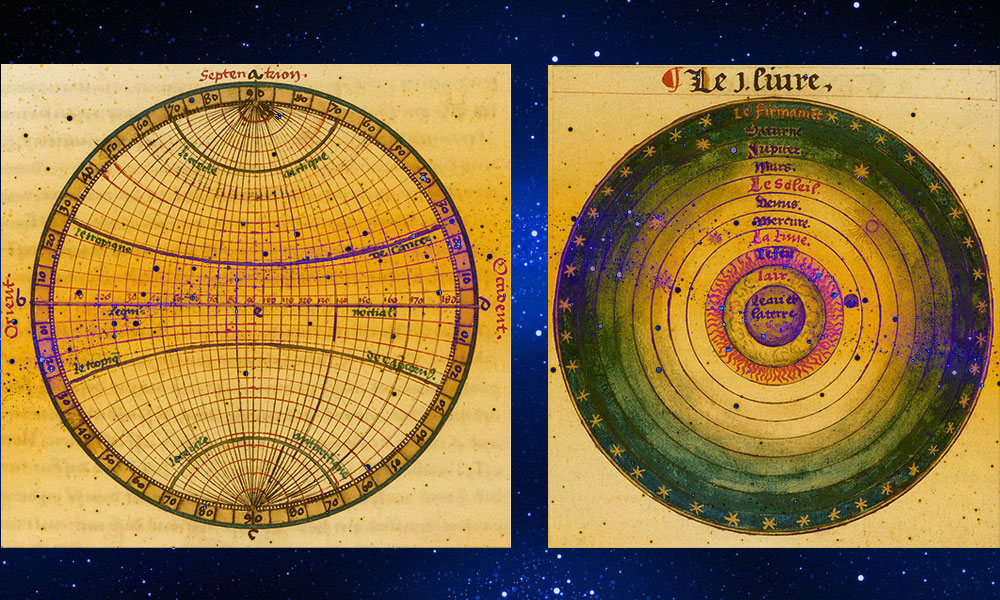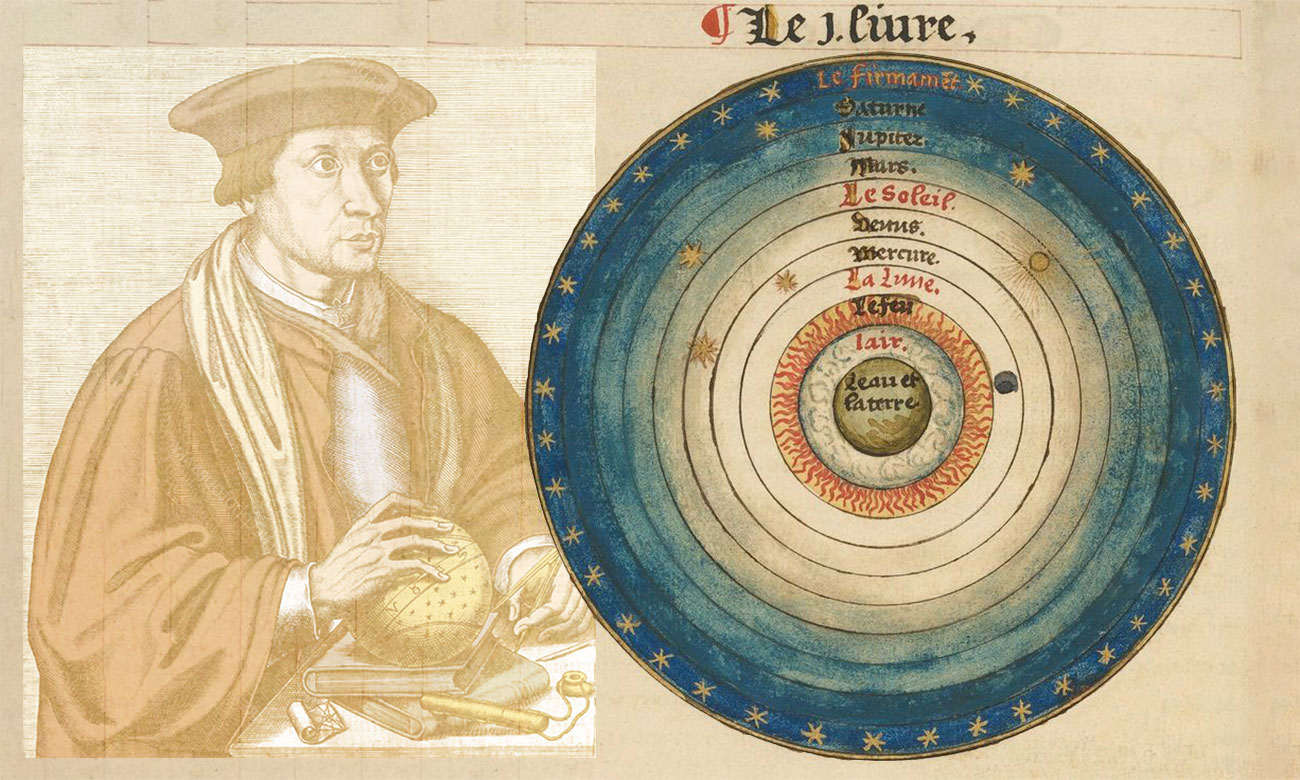
In the wake of the greatest genius of the time, Leonardo da Vinci, is this inspired astronomer. He laid the foundations for terrestrial and celestial mapping. His maps and drawings make us travel in ourselves, in the past, in space and in the legend of the world. His name? Oronce Fine or Orontius Finaeus in Latin. He is French but the French have forgotten him.
I myself knew nothing of him until the shocking discovery of his various scientific schemes that must have inspired Jules Verne, the Schuiten brothers and many other artists. Including my new graphic designer, Iksevior, who was happy to add background backgrounds, to better present the works of Fine.
Mathematician, Astronomer, Cartographer
Oronce Fine or Oronce Finé, Orontius Finaeus Delphinas in Latin, was a French mathematician, astronomer and cartographer born on December 20, 1494 in Briançon and died on August 8, 1555 in Paris. His Protomathesis is a course in pure and applied mathematics. At that time, terrestrial geography was part of astronomy.
The great discoveries of his century directed mathematicians towards the calculation of longitudes and latitudes, which brought Oronce Fine to cartography. It is in this branch that his creativity and visionary talent will first express itself.
Oronce Fine is the first cartographer in France to have represented newly discovered continents on world maps, coordinating the information given by browsers, and giving access to these maps to the public. In 1520, he made the first map of France named Gallia published in 1525. This realization seems to have contributed to its notoriety. In 1531, François I invited him to be part of the group of scholars at the origin of the Collège de France. He was the first Chair of Mathematics at the Collège de France (1531-1555). He is also the author of a world map in the shape of a heart and presenting a Terra Australis: the map of Oronce Fine. In 1935, the International Astronomical Union named the lunar crater Orontius after the French astronomer Oronce Finé.
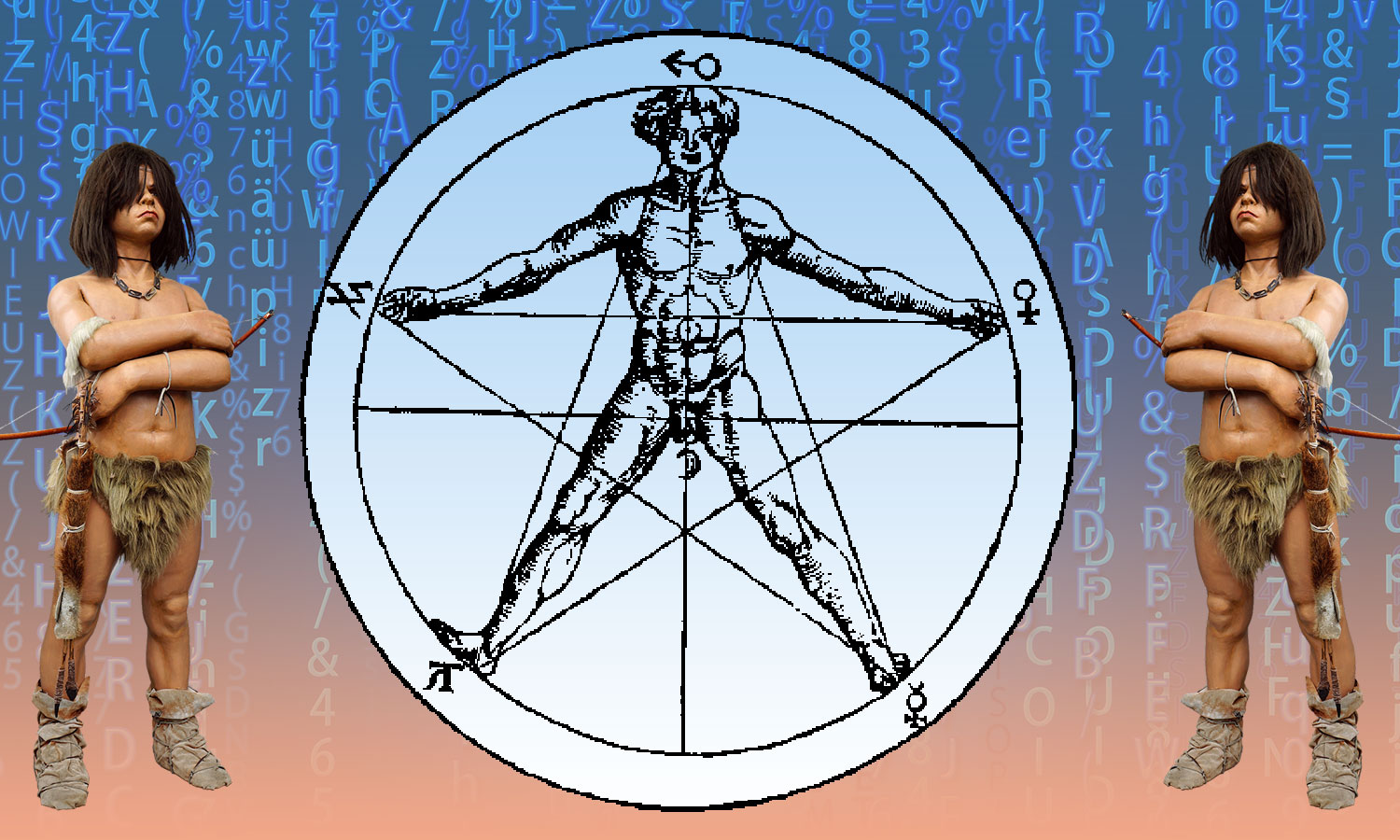
Studies
The Fine family originated in Villar-Saint-Pancrace (village adjoining Briançon) in the 14th century. His father, François Fine, practices medicine but is also interested in astronomy and created an instrument to observe the movements of the planets. However, the father seems to have died quite young and Oronce Fine, still a child, is sent to Paris to a compatriot named Antoine Silvestre, who teaches the beautiful letters at the College of Montaigu and then at the College of Navarre. Oronce Fine studied humanities and mathematics at the same College of Navarre.
He is the first cartographer in France to have represented on world maps the newly discovered continents, coordinating the information given by the navigators, and giving access to these maps to the public. To achieve this, he had to edit them himself.
He also drew up a large map of France from the early 1520s, which he published in 1525. This achievement contributed to his growing reputation. A few years later, he was one of the most eminent scholars of the time. In 1531, Francis I invited him to be part of the group of scholars at the origin of the Collège de France. (source)

The Esphere of the World
The Sphere of the World (original title in Middle French: L’Esphere du Monde) is a mapping work developed in 1549 by Oronce Fine, and dedicated to King Henry II. It is written in French, although the first version was written in Latin in 1542. The book presents the particularity of presenting the Antarctic continent.
Fifteen years ago, dear reader, we conceived for the first time, in the form of a human heart, this universal map of the world, in recognition of the Most Christian and Most Powerful Francis, King of the French, our most clement Patron. For although we have seen it please the King, a polymath and an extraordinary geographer, and it has been praised by many, even in foreign countries, I have finally wanted to communicate the same description of the whole globe to all mathematics students: who, after fortunes and crises in the studies we have conducted, which so far have been an obstacle to us, we have finally done so at our peril. (Oronce Fine, 1549)
At the time the work was conceived, cartographers from various European countries and the Middle East had to show intelligence and skill to acquire vital information for trade and knowledge; especially since Spain and Portugal kept absolute secrecy about their discoveries, useful for obtaining materials and evangelizing the native peoples. Thus, the cartographers were paying attention to rumors that came from pirates, sailors or others, hoping that their imagination did not create them problems.

Terra Australis Incognita
The details of new territories were constantly being updated, until several experts such as Copernicus and Mercator claim the existence of a land mass in the southern hemisphere called Terra Australis Incognita to balance the lands of the northern hemisphere. (wikipedia)
It was the time when Fine created a pseudo-conical projection that became popular in the 16th century before being abandoned. The pseudo-conical shape proposed by Oronce Fine is actually a heart-shaped planisphere.see below
It was almost forgotten and lost, until Charles Hapgood discovered it in the Library of Congress in Washington (USA), alongside other maps of the time that he collected in his book Maps of Ancient Sea Kings.
First Planetary Clock
The Sainte-Geneviève library in Paris still houses an epicyclical planetary clock, called «Oronce Fine clock». It is the oldest of the planetary clocks present in France.
This clock is generally considered to have been built by Oronce Fine for Cardinal Charles de Lorraine but, in reality, Oronce Fine discovered it in Metz before transforming it. Its modifications, made in 1553, allowed a distribution in five frames instead of 4 previously, with addition of the face of the astrolabe; the other faces, initially present and welcoming the planets, are potentially from the late 15th or early 16th century.
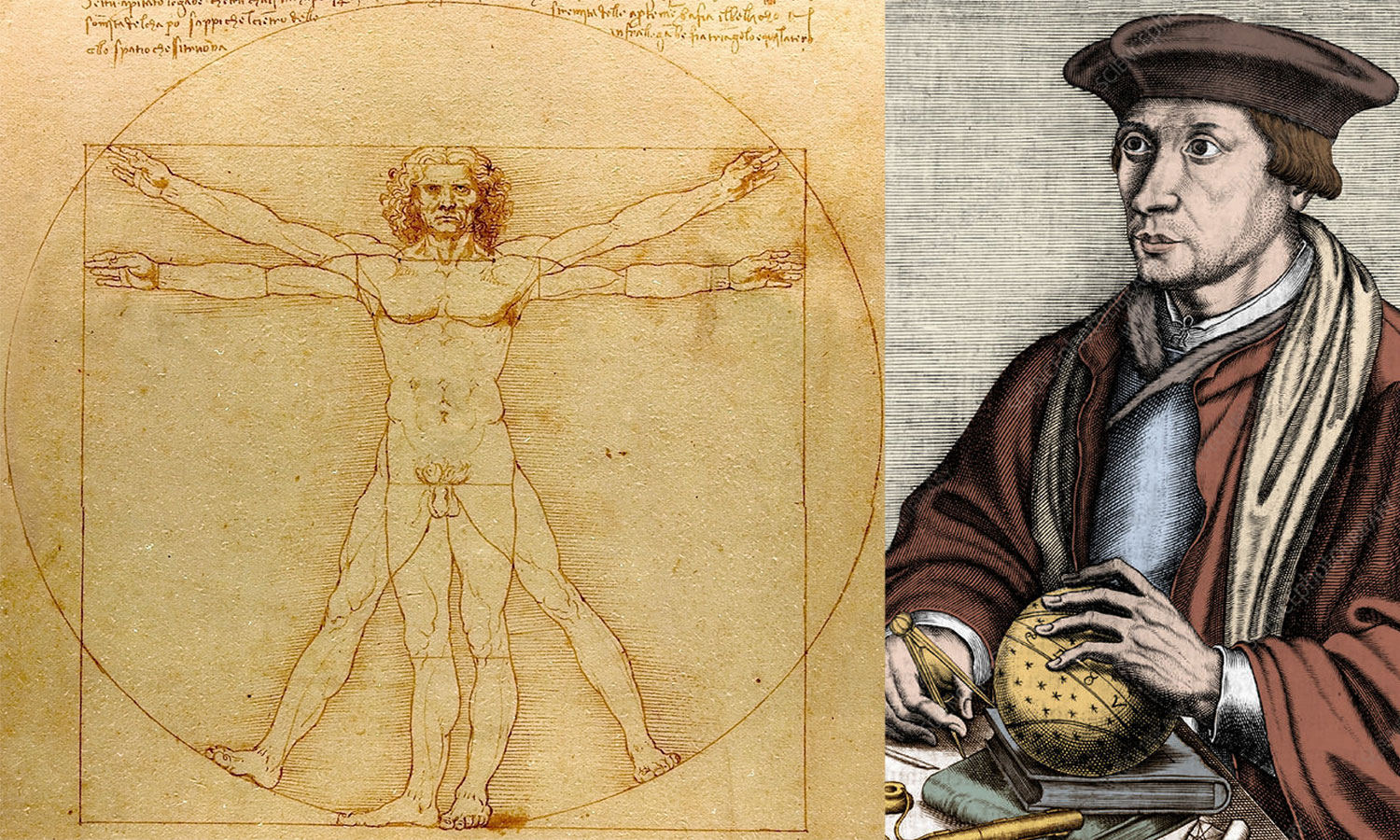
The Human Body
Even more than his maps or his clock, Oronce Fine’s compositions on the proportions of the human body participate in the genius of the century of Francis I, bringing him closer to another exceptional creative spirit, Leonardo da Vinci. It is possible that the two men met, being both familiar with the court of the king of France. But it is doubtful that they have long dated. Vinci died in 1519, while Fine was not yet recognized, he would not publish his first works until the following year, in 1520.
This did not prevent the great astronomer to develop an artistic vision very close to the inspiration of the major artist Vinci. This influence is particularly noticeable when comparing his works with Leonardo da Vinci’s famous Vitruvian Man.See above Here are several drawings on the same theme, all by Oronce Fine. They irresistibly evoke the influence of Vinci. My graphic designer integrated them into his own works, notably to illustrate a recent page, The Inner Source.
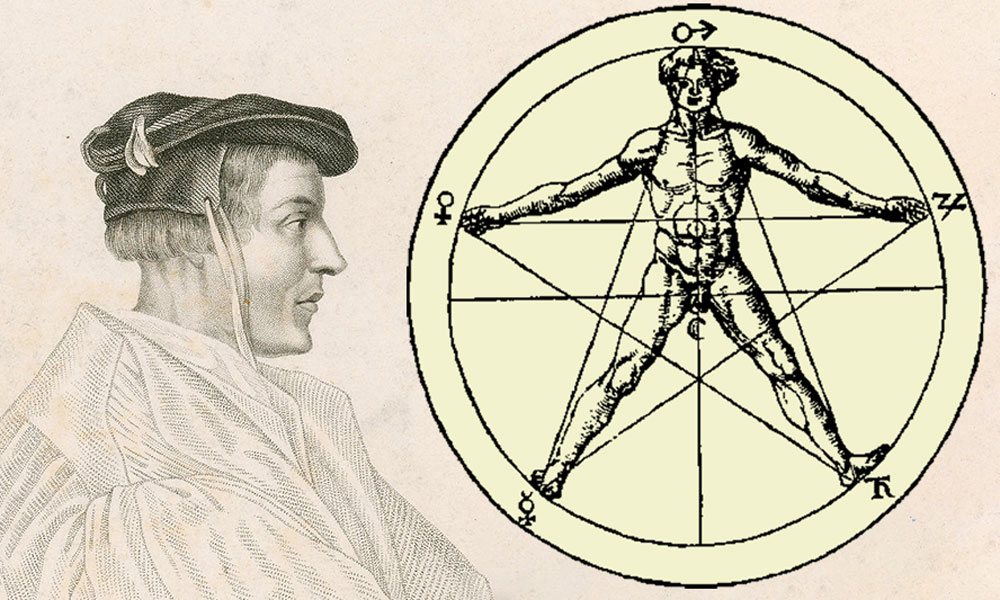
Proportions
The proportions of the human body have often been proposed as standard, reference, absolute standard that defines all other proportions. I suppose that if we had had the body of an ant, our scientists would have been as many to proclaim our perfect and flawless formic body. He would have become de facto the only stallion of the terrestrial and celestial bodies of the past, the present and the future. The ants had the wisdom to abstain.
The fatuity of our species is immeasurable. When our stupid scientists wonder if there is life elsewhere than here, they testify exactly the same disproportionate ego. In terms of hypothesis, if caution is recommended, anthropocentrism should be banned. Given the narrow-mindedness and pride that reign in the so-called human sciences, anthropocentrism still has good years ahead. As for getting rid of it permanently, we may be able to do so in a few centuries — if our stupidity hasn’t made us disappear before.
Pride or naivety? Either is the fruit of a religious lie, as we shall see.

The Esphere of the World
The Sphere of the World (original title in Middle French: L’Esphere du Monde) is a mapping work developed in 1549 by Oronce Fine, and dedicated to King Henry II. It is written in French, although the first version was written in Latin in 1542. The book presents the particularity of presenting the Antarctic continent.
Fifteen years ago, dear reader, we conceived for the first time, in the form of a human heart, this universal map of the world, in recognition of the Most Christian and Most Powerful Francis, King of the French, our most clement Patron. For although we have seen it please the King, a polymath and an extraordinary geographer, and it has been praised by many, even in foreign countries, I have finally wanted to communicate the same description of the whole globe to all mathematics students: who, after fortunes and crises in the studies we have conducted, which so far have been an obstacle to us, we have finally done so at our peril. (Oronce Fine, 1549)
At the time the work was conceived, cartographers from various European countries and the Middle East had to show intelligence and skill to acquire vital information for trade and knowledge; especially since Spain and Portugal kept absolute secrecy about their discoveries, useful for obtaining materials and evangelizing the native peoples. Thus, the cartographers were paying attention to rumors that came from pirates, sailors or others, hoping that their imagination did not create them problems.

Terra Australis Incognita
The details of new territories were constantly being updated, until several claims made of a land mass in the southern hemisphere called Terra Australis Incognita had to balance the lands of the northern hemisphere, what other experts such as Copernicus and Mercator also claimed.
This unknown land at the time is Antarctica. The question therefore arises as to why it is represented free of ice, with the mouths of coastal rivers today under meters of sea ice, and the separation between the two islands of the Antarctic continent. I dealt with this issue in a previous article, so I will not come back to it here.
The major contribution of Fine, geographer and cartographer, is his creation of a pseudo-conical projection that became popular in the 16th century before being abandoned. The pseudo-conical shape proposed by Oronce Fine is actually a planisphere in the shape of a heart.See further
It was almost forgotten and lost, until Charles Hapgood discovered it in the Library of Congress in Washington (USA), alongside other maps of the time that he collected in his book The Maps of the Ancient Kings of the Seas.
First Planetary Clock
The Sainte-Geneviève library in Paris still houses an epicyclical planetary clock, called the Oronce Fine clock. It is the oldest of the planetary clocks present in France.
This clock is generally considered to have been built by Oronce Fine for Cardinal Charles de Lorraine but, in reality, Oronce Fine discovered it in Metz before transforming it. Its modifications, made in 1553, allowed a distribution in five frames instead of 4 previously, with addition of the face of the astrolabe; the other faces, initially present and welcoming the planets, are potentially from the late 15th or early 16th century.
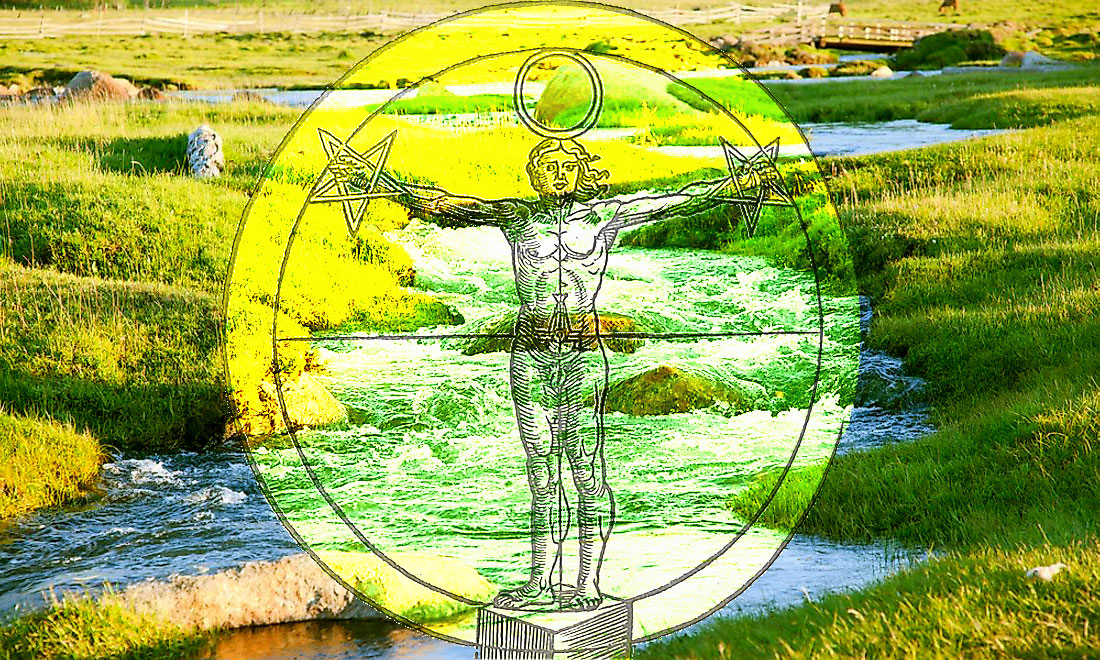
Triple Master
Oronce Fine is not only a mathematician, astronomer and cartographer. He is also interested in esotericism, as this image shows. Interesting detail: this Vitruvian man holds in his hands five-pointed stars that offer the particularity of being traced in a single stroke. They are the stars of alchemy and gnosis. Masonic symbol, one of them would have appeared on the coat of arms of Hermes Trismegistus, Three Times Master.
Hermes Trismegistus literally means three times the largest. A mythical character from Greek-Egyptian antiquity, he is said to have written a set of texts called Hermetica, the best known of which are the Corpus Hermeticum, a collection of mystical-philosophical treatises, and the Emerald Table. The hermetists, who owe their name to him, and the alchemists claim to be him.
One can only admire Oronce Fine’s complex and complete personality and the open-mindedness he has shown throughout his life. Few scientific or para-scientific fields have not aroused his interest. This universal spirit deserves our consideration and I had to do it justice in memory of the great man he knew to be.
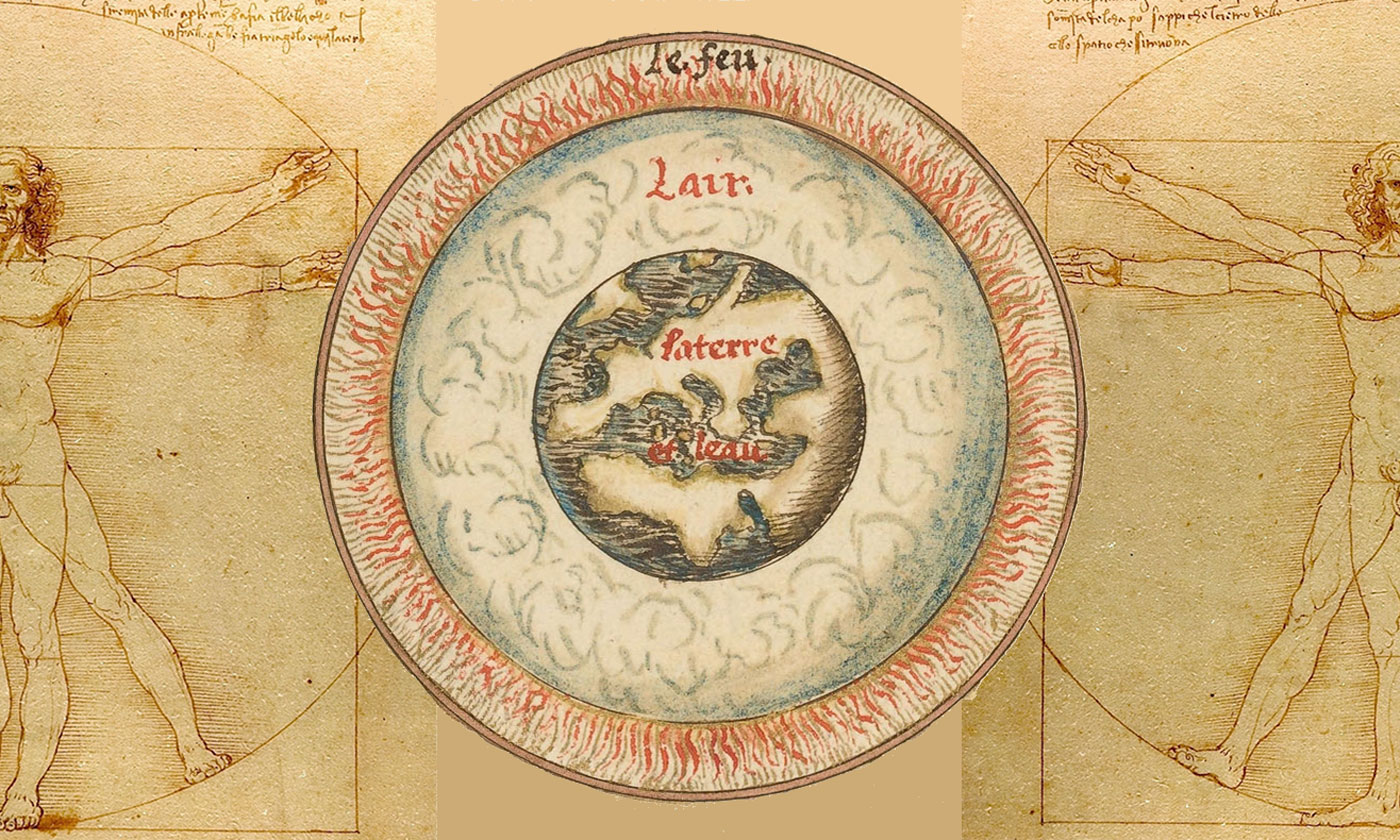
The Spheres of the Earth
The astronomy of the 16th century is not ours, as will be judged from the celestial spheres that I present here. The first, above, I put it in touch with the Man of Vitruvius, famous drawing of his contemporary Leonardo da Vinci.
These old drawings fascinate me, which is not surprising: I had a career in comics and can only rejoice to discover that a scientist could once compete with my favorite authors.
While today, our learned astronomers trace their drafts on computer screens, in the time of Oronce Fine they worked with goose pen on vellum, paper comparable to the parchment obtained from a calf skin, hence its name.
False Beliefs
What matters the inaccuracies? Every era has its own. I imagine the jeers and mockery of the students of the future in front of the advanced point of the current research, which will seem to them just as naive, obsolete and silly, faded, outdated.
I now offer you a selection of the nicest cartographic drafts of the different spheres imagined by our astronomer.starry skies were added by my graphic designer At the center, of course, our good old planet earth. In his time, it was still believed that our planet was at the center of the universe.
This naivety comes straight from religious lies. God sent his only son here because there is only one habitable earth, our planet. That’s why it is the centre of the universe. The fatuity of our species is immeasurable indeed.
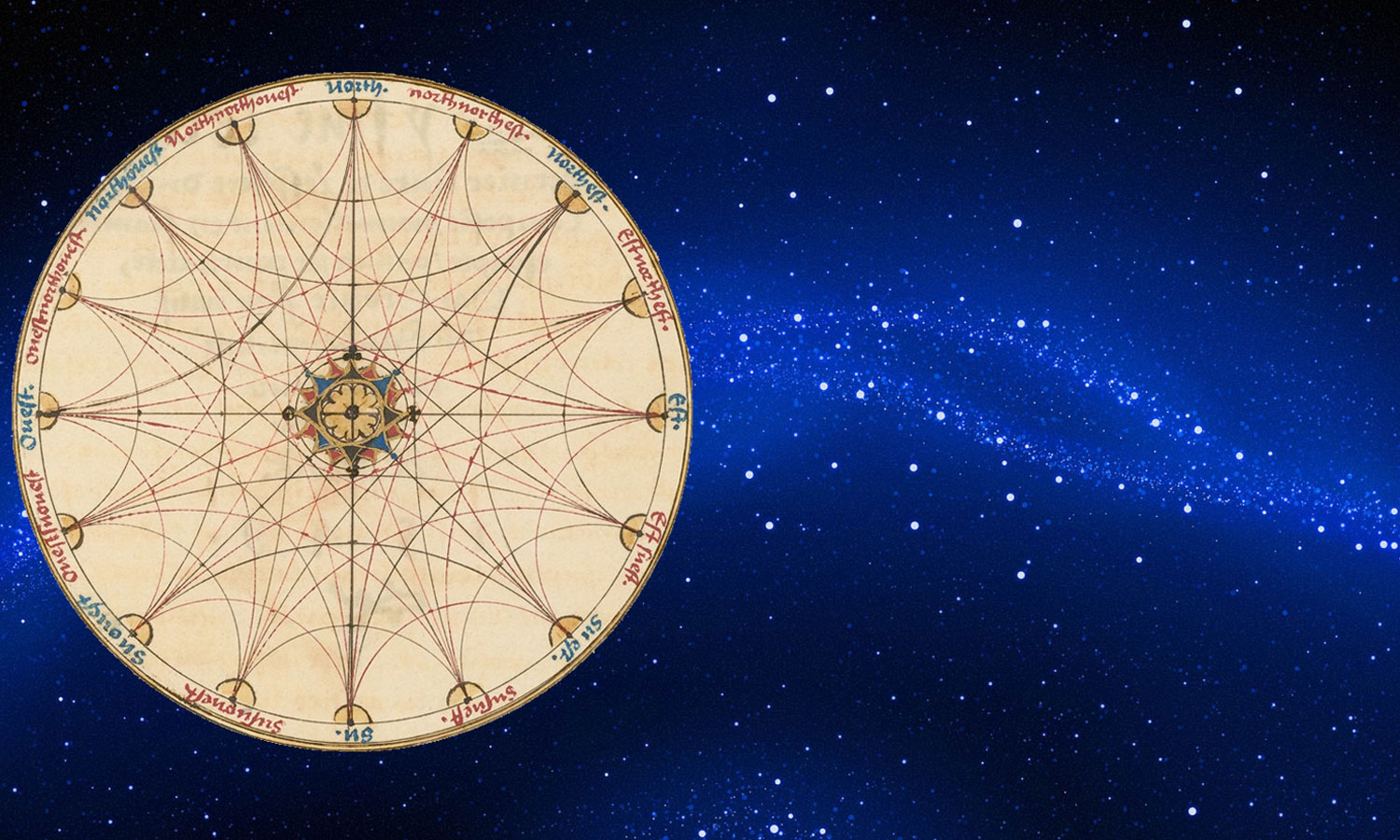
Dumb Asses
This conclusion seems logical. Popular naivety is not at issue, while the stupidity of Christianity is proven. This is just another of his misdeeds, and not the worst, far from it! The list would be too long of the serious violations of knowledge caused by religions. Is it not the wish of all beliefs, to spread stupid nonsense so that their flock remains stupid donkeys?
When one thinks that all the primitive religions, the old religion of the druids, the mystery cults (1) (2) (3) (4), the animisms of Africa and elsewhere, the fetishes, the ancient religion of the pyramids, all without exception were paths of awakening. Not a single one survived.
Those that remain are religions of falling asleep. All, without exception. If believing is indispensable to the warrior of light, he will take care to believe without believing. As for the others, blinded followers, they will never reach enlightenment…
In places of worship as in the heads of the faithful resounds this eternal antiphon: Sleep, I want it! Pay your religious taxes, religious monies, taxes, quests, various contributions. Always be good believers, good citizens, good patriots, good balls and above all sleep well. Even more deeply! I want it!

Great Popularity
Oronce Fine was the first mathematics teacher to become a royal lecturer, which made him extremely popular throughout France. The crown entrusted him with the delicate mission of making mathematics more transparent. He also reformed the curriculum and the way of teaching practised in France.
Fine was forced to become a publisher. To disseminate his new teaching and the developments of his work, he published the sum of his research in his Protothesis. This included, in addition to basic mathematics, his teaching of practical mathematics. This innovation complemented traditional mathematics by making them more concrete. The Protothèse profoundly changed the way mathematics was taught and perceived in France.
Fine proposed several approximations of the value of pi. He gave it as 3.1746 in 1544. Later he gave 3,1333 and, in De rebus mathematicis (1556), he gave 3,1410.
